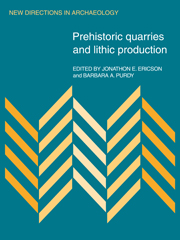Book contents
- Frontmatter
- Contents
- List of contributors
- Dedication
- Part 1 Introduction
- Part 2 Procurement, production, and exchange
- 2 Mount Jasper: a direct-access lithic source area in the White Mountains of New Hampshire
- 3 Procurement without quarry production: examples from southwestern Idaho
- 4 The 63-kilometer fit
- 5 Monopoly or direct access? Industrial organization at the Melos obsidian quarries
- 6 Lithic material demand and quarry production
- 7 Economic aspects of prehistoric quarry use: a case study in the American southwest
- 8 Preliminary report on the obsidian mines at Pico de Orizaba, Veracruz
- 9 State-controlled procurement and the obsidian workshops of Teotihuacán, Mexico
- Part 3 Technology and techniques
- Index
5 - Monopoly or direct access? Industrial organization at the Melos obsidian quarries
Published online by Cambridge University Press: 04 August 2010
- Frontmatter
- Contents
- List of contributors
- Dedication
- Part 1 Introduction
- Part 2 Procurement, production, and exchange
- 2 Mount Jasper: a direct-access lithic source area in the White Mountains of New Hampshire
- 3 Procurement without quarry production: examples from southwestern Idaho
- 4 The 63-kilometer fit
- 5 Monopoly or direct access? Industrial organization at the Melos obsidian quarries
- 6 Lithic material demand and quarry production
- 7 Economic aspects of prehistoric quarry use: a case study in the American southwest
- 8 Preliminary report on the obsidian mines at Pico de Orizaba, Veracruz
- 9 State-controlled procurement and the obsidian workshops of Teotihuacán, Mexico
- Part 3 Technology and techniques
- Index
Summary
Quarry-production analysis can profitably be applied to the study of prehistoric exchange. By adopting a systems perspective, hypotheses about the nature of past human behavior at a quarry site can be derived from theories of raw material exchange and then tested against the data collected from the site. Using this innovative approach to study the obsidian quarries at Sta Nychia and Demenegaki on the island of Melos, Greece, the monopolization of source areas and/or the use of a highly organized, efficient, and specialized production technology were predicted in conjunction with commercial, market exchange of obsidian in the Aegean area. Detailed site survey and sampling strategies combined with analyses of the tools and techniques involved in quarrying obsidian and the manufacture of preform blade cores did not confirm the hypotheses. In contrast, the actual reconstruction of obsidian procurement on Melos as inefficient, unsystematic, and undertaken for short periods by nonspecialist laborers supports the opposing theory for direct access to the sources.
Introduction
The study of prehistoric obsidian exchange in the Aegean basin has been greatly facilitated by the application of a wide range of physicochemical techniques to a very substantial series of samples. These analyses have demonstrated that for all practical purposes the outcrops on the Cycladic island of Melos were the sole sources of the obsidian found in varying quantities on sites, dating from about 12,000 to 3,000 years B.P., which are distributed over the whole of the Greek peninsula and throughout the Aegean islands (Cann & Renfrew 1964; Renfrew, Cann & Dixon 1965; Dixon, Cann & Renfrew 1968; Dixon 1976; Shelford et al. 1982; Aspinall, Feather & Renfrew 1972; Durrani et al. 1971; McDougall 1978; Perlès 1979).
- Type
- Chapter
- Information
- Prehistoric Quarries and Lithic Production , pp. 49 - 64Publisher: Cambridge University PressPrint publication year: 1984
- 16
- Cited by



